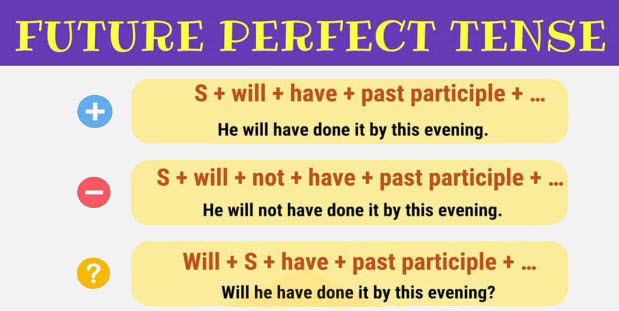ساختار زمان آینده کامل :

استثناهای شکل سوم افعال :
1. اگر انتهای فعل e داشت تنها کافی است برای ساختن شکل سوم به آن d اضافه کنیم : love – loved
2. اگر حرف یکی مانده به آخر صدادار و استرسدار باشد، حرف بی صدای آخر فعل دوبار تکرار میشود : admit – admitted
3. در انگلیسی بریتانیایی اگر آخر فعلی L باشد دوبار تکرار میشود، اما در انگلیسی آمریکایی L یکبار میآید :
travel – travelled (انگلیسی بریتانیایی)
travel – traveled (انگلیسی آمریکایی)
منفی و سوالی کردن زمان آینده ساده :
برای سوالی کردن ان تنها کاری که باید انجام بدهید این است که Will زا به اول جمله ببرید.
کلمات به رنگ نارنجی،کوتاه شده قسمت قبل هستند.هنگام به کاربردن این زمان اغلب فاعل و فعل کمکی را به طور خلاصه به کار می بریم.
در جملات منفی not ، به جای فاعل و فعل کمکی، فعل کمکی را همراه با not به شکل won’t خلاصه می کنیم (همراه با تغییر شکل در will مثلا it will not میشود : it won’t )
| ساختار جمله | نوع جمله |
| . I will (I’ll) have finished by 10 am | + |
| . You will (You’ll) have forgotten me by then | + |
| . She will not (won’t) have gone to school | – |
| . We will not (won’t) have left | – |
| ? Will you have arrived on time | ? |
| ? Will they have received it | ? |
نکته: گاهی اوقات shall را به جای will به کار میبریم. خصوصا برای I و . we
کاربرد زمان آینده کامل در زبان انگلیسی
- اگر کاری را در آینده در زمان مشخصی به پایان برسانیم از زمان آینده کامل استفاده می کنیم.
Ghazal will have done a lot of sports by the end of summer
I will have finished my education by the end of this year
Before you leave this page, you will have learnt how to use Future Perfect tense
- برای نشان دادن مدت زمان چیزی و یا کاری در آینده
They will have been in the us for 10 years this October
I will have worked as an animator for 7 years by the end of this week
نکته: اگر بخواهیم از قید هایی همچون certainly, already… استفاده کنیم باید ان را بعد از Will قرار دهیم.
She will certainly have finished her education by the end of this summer
They will probably have finished the project by the end of this year
چطور از زمان آینده کامل استفاده کنیم ؟
زمان آینده کامل بیانگر عملی درآینده قبل از عملی دیگر درآینده است. که به آن گذشته در آینده نیز می گویند. به عنوان مثال:
The train will leave the station at 9 am. You will arrive at the station at 9:15 am. So: When you arrive the train will have left.
The train will have left when you arrive.
به مثال های زیر توجه کنید:
You can call me at work at 8am. I will have arrived at the office by 8 am.
They will be tired when they arrive. They will not have slept for a long time. “Marry won’t be at home when you arrive”. Really? Where will she have gone?




